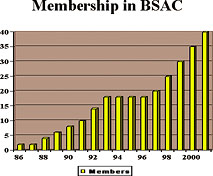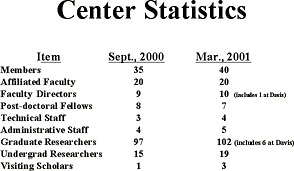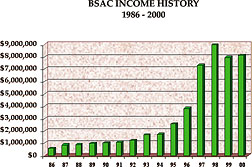

Berkeley Sensor & Actuator Center (BSAC)
University of California at Berkeley (lead) and University of California at Davis
A National Science Foundation Industry/University Cooperative Research Center since 1986
Creating tomorrow's integrated microelectromechanical systems (MEMS)

|
Center Mission and Rationale
The mission of the Berkeley Sensor & Actuator Center (BSAC) is to develop a science, engineering, and technology base for microsensors, microactuators, mechanical microstructures, and microelectromechanical systems (MEMS). The Center builds upon its well-developed foundation of design and fabrication tools to create to create tomorrow's microelectromechanical systems.
Research Program
Founded in 1986, the Center is supported by roughly 40 industrial and national laboratory members, with whom it collaborates closely. Frequently, researchers at BSAC base their research on the requirements of Center members, who may test devices, structures, and/or systems made at BSAC or supply the Center with materials to evaluate.

|
The BSAC research thrusts are in several areas.
- Scientific Fundamentals -- Physics and engineering at small dimensions, materials and mechanisms for microdevices, ultrasound and energy transduction in microstructures, material properties, fluid flow in small channels, properties of alloys of semiconductor materials, and new physical phenomena for sensing and/or actuating
- Fabrication Techniques and Materials -- Technologies for material sculpting, bulk and surface micromachining, deposition of piezoelectric and magnetic films, control over basic material properties, compatible fabrication of micromechanical and microelectronic devices and circuits, novel etch release methods, high-aspect ratio microstructures, material joining and cutting, and microdevice packaging techniques; as well as new MEMS materials, new LPCVD and other deposition techniques, and packaging technologies
- Microdevices for Sensing and Actuation -- Force, pressure, strain, and motion-sensitive devices; microfluidic pumps, valves, and flow-rate measuring devices; ultrasonic flexural-wave devices; microphones; chemical sensors and chemical-reaction devices; optical microdevices; micropositioning and microgripper devices; and mechanically resonant microdevices and miniature inertial instruments such as accelerometers, angular rate sensors, and angular accelerometers
- Integrated Microsystems -- Integrated process development for micromechanics and microelectronics where Complimentary Metal-Oxide-Silicon (CMOS) circuitry is fabricated along with microstructures, integrated-circuit microphones, contactless integrated electrostatic voltmeters, microminiature light choppers, resonant-element microcircuits and systems, microaccelerometers, microminiature rate-gyros, micro-flow systems for biological and chemical applications, high-accuracy, high-bandwidth micropositioners for disk drives, and microphotonic systems.
Recent research projects at BSAC include filters for electrical filters that are made using micromechanical elements, sophisticated biochemical processing in a micromachined container, advanced micromachined inertial instruments, high-aspect ratio microactuators, novel piezoelectric sonic-output devices, and micro-optical scanners and switches. A project labeled "smart dust" is demonstrating procedures to distribute sensing nodes that can be interrogated remotely.

|
Special Center Activities
The Center uses the microfabrication laboratory of the University of California at Berkeley, which is one of the most advanced lab sites in the field. Mask-making can be done on-site. Students perform most of the fabrication, and the facility allows carefully monitored nonstandard processing to be performed in the laboratory, permitting unusual design flexibility. The BSAC multidisciplinary student mix (engineering and science students in the electrical, mechanical, chemical, material science, and bioengineering areas) brings together a broad skills base. BSAC also employs a full-time staff that specializes in process optimization and novel fabrication techniques.
Examples of unique devices fabricated by BSAC include microresonators, microphotonic systems, microphones, ultrasonic sensors, microhypodermic injection needles, microsignal processing filters, microencapsulation shells, micropumps, and micromixers that employ both low-stress membranes and piezoelectric films. BSAC develops processes to combine sensor structures with both low- and high-temperature metallization to make fully integrated sensors, actuators, and electronic circuits. At BSAC, a pioneering effort has introduced thin-film deposited silicon/germanium for MEMS.
BSAC Facts
- Research programs are available for undergraduate, graduate, and postdoctoral students, employing more than 100 graduate students.
- Center alumni are active in MEMS in industry and at major laboratories and universities, including those at UCLA, University of Michigan, Carnegie Mellon University, Case Western Reserve, California Institute of Technology, University of Southern California, University of Wisconsin, University of Maryland, and Lawrence Livermore National Laboratory.
- The Center draws on past and present collaborations with the Center for Nondestructive Evaluation at Iowa State University, the Center for Process Analytical Chemistry at the University of Washington, the Center for Dielectric Materials at the Pennsylvania State University, Case-Western Reserve University, and the Center for Engineering Tribology at Northwestern University.
- Collaborative research involves faculty colleagues at Berkeley and other universities, including the University of California at Davis, Stanford, MIT, the University of Michigan, Carnegie-Mellon University, and Princeton University.
Center Headquarters
Berkeley Sensor & Actuator Center
University of California at Berkeley
Department of EECS
497 Cory Hall
Berkeley, CA 94720-1774
Tel (510) 643-6690 * Fax (510) 643-6637
Homepage: www-bsac.eecs.berkeley.edu/
and
University of California at Davis
3131 Engineering II
Department of ECE
Davis, CA 95616-5294
Tel (530) 754-9267 * Fax (530) 752-8428
Center Co-Director: Dr. Bernhard E. Boser
boser@eecs.berkeley.edu
Center Co-Director: Dr. Roger T. Howe
howe@eecs.berkeley.edu
Center Co-Director: Dr. Luke P. Lee
lplee@socrates.berkeley.edu
Center Co-Director: Dr. Dorian Liepmann
liepmann@me.berkeley.edu
Center Co-Director: Dr. Liwei Lin
lwlin@me.berkeley.edu
Center Co-Director: Dr. Richard S. Muller
muller@eecs.berkeley.edu
Center Co-Director: Dr. Albert P. Pisano
appisano@me.berkeley.edu
Center Co-Director: Dr. Kristofer S. J. Pister
pister@eecs.berkeley.edu
Center Co-Director: Dr. Norman C. Tien
tien@ece.ucdavis.edu
Center Co-Director: Dr. Richard M. White
rwhite@eecs.berkeley.edu
Center Evaluator: Dr. Howard Levine
(510) 849-0358 * hlevine2@earthlink.net
NSF 01-168ii